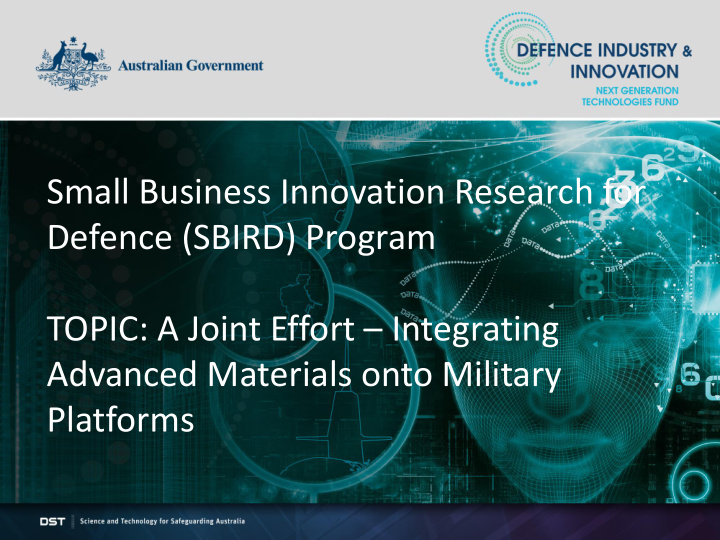



Small Business Innovation Research for Defence (SBIRD) Program TOPIC: A Joint Effort – Integrating Advanced Materials onto Military Platforms 1
SBIRD & the Next Generation Technologies Fund • $730M over 10 years • Described in the Defence Industry Policy Statement 2016 • For investment in new innovative game changing technologies 2
The SBIRD Program What is SBIRD? • Competitive merit based competition • Companies submit proposals in response to Calls Four Aspects to the Topic: Two Stage Program 1. Integration of Composites 2. Adhesives for Structural Joining Stage 1 – Technology Feasibility Stage 2 – Technology Application • • Funding up to $150,000 per project Additional Funding per project 3. High Temperature Structures • • 6-9 month duration 12-24 month duration 4. Improved Armour Systems • • Research into the technical feasibility Testing of the idea or technology of an innovative idea or technology against the application 3
The Parallel Call • SBIRD & DASA similar framework • Both countries release the same call for proposals • Proposals lodged and processed through the DASA automated online system – Link available from the Defence Innovation Portal • Proposals assessed jointly by subject mater experts from DST and the UK Defence Science Technology Laboratory (dstl) • Successful proposals funded by country of origin • Both countries providing a similar level of funding 4
Parallel Call Assessment Criteria • Desirable – Strategic fit – End User Pull – Defence & Security Compatibility • Feasible – Technically credible – Innovation & Risk – Expertise & capability • Viable – Project Delivery – Exploitation beyond SBIRD – Costs & Value for Money 5
What to Think About in Developing Your Proposals Area of particular interest include: • Enabling new material combinations; • Novel approaches to the integration of advanced or novel materials; • Increasing joint durability in military operating conditions; • Joints that allow easier modification/replacement of components or subsystems on a platform; • Health and usage monitoring of joints 6
Parallel Call Contracting • Applications through Australia – Standard terms and conditions – Industry: Next Generation Technologies Fund Research Contract – Academia: Defence Science Partnerships Deed • Applications through DASA – Standard terms and conditions – DEFCON 705 Getty Images Olga Kashurina 7
A Joint Effort – Integrating Advanced Materials onto Military Platforms Technology Brief: Integration of Composites Andrew Rider 8 8
Integration of Composites • Composite use established on aircraft and push to expand their use on ships and land vehicles • On aircraft many uses and benefits including reduced corrosion and weight • Composite benefits include reduction in weight topside for maritime platforms • Land vehicle applications include wear resistance and lightweight for greater mobility 9
Integration of Composites • Composite to metallic joint issues: – Thermal mismatch – Response to fire – Reaction to shock – Reaction to water: swelling, corrosion in joints – Closure openings: doors, hatches, covers • Rapid repair of composite interfaces • Joining of Additively Manufactured parts – Reliability – Build of AM parts using different materials 10
A Joint Effort – Integrating Advanced Materials onto Military Platforms Technology Brief: Adhesives for Structural Joining John Wang 11 11
Adhesives for Structural Joining • Advantages of Adhesives • Disadvantages of Adhesives – Reduction in weight – Surface preparation requirements – Reduced damage to substrates – Adequate non-destructive inspection techniques (material – Increased fatigue performance state awareness) – Ability to join dissimilar materials – Environmental exposure – Eliminates corrosion due to – Long term durability dissimilar metals – Disassembly issues – Reduced manufacturing cost 12
Adhesives for Structural Joining • Defence environments – In field contaminants – Variable surface preparation – Exposure conditions (UV, salt, humidity, temperature…) • Novel fabrication and bonding – Initial and on-going bond structure integrity assessment/monitoring – Temporary repair technologies – Dissimilar materials (e.g. composite to metal; aluminium to steel) – Bond disruption on demand – Replacement for welding 13
A Joint Effort – Integrating Advanced Materials onto Military Platforms Technology Brief: High Temperature Structures John Thornton 14 14
High Temperature Structures • Requirement for materials and structures that can operate at high temperatures • Airframe and propulsion systems • Complex loadings – Geometry, Out of plane loading, Shock and vibration Ceramics Protecting Metals in Gas Turbine Engines Zirconia Ceramic NiCoCrAlY Bond Coat Ultra-High Temperature Ceramic o C 0.1 mm During Thermal Testing at 3000 Nickel Superalloy 15
High Temperature Structures • Thermal protection skins • Refractory metals may be pushed to their thermal and structural limits • Ceramic or ceramic-matrix-composites • Joints must accommodate thermal expansion mismatch between materials Thermal Expansion Mismatch Leads to Cracking The Silicon Carbide Ceramic Carbon/Carbon for structural for Oxidation Resistance strength and toughness at extreme temperatures 16
A Joint Effort – Integrating Advanced Materials onto Military Platforms Technology Brief: Improved Armour Systems Darren Edwards 17 17
Improved Armour Systems • A need for platform and soldier armour for a range of operational situations – New and constant evolving threats – Extremes: temperature, loading – Increased mobility • Requirements – Maintain protection capability – Lightweight – New materials and solutions – Low maintenance, reduced through-life costs – Availability 18
Improved Armour Systems • Transparent armour systems – Lightweight transparent ceramics – High performance interlayers and polymers – High integrity bonding • Durability- environmental exposure • Interface enhancement- resist de-bonding • Novel manufacturing processes • Innovative inspection techniques – Quality and degradation assessment 19
Key Dates Topic Open 28th November 2018 28 th November 2018 Information Event Pre bookable 1 on 1 December 2018 – January telecom sessions 2019 Topic Closes 2300 (Eastern Daylight Savings Time (1200 GMT) 1 February 2019 Contracting Aim to start in March / April 2019 20
Questions E: SBIRD@dst.defence.gov.au www.business.gov.au/cdic 21
Recommend
More recommend